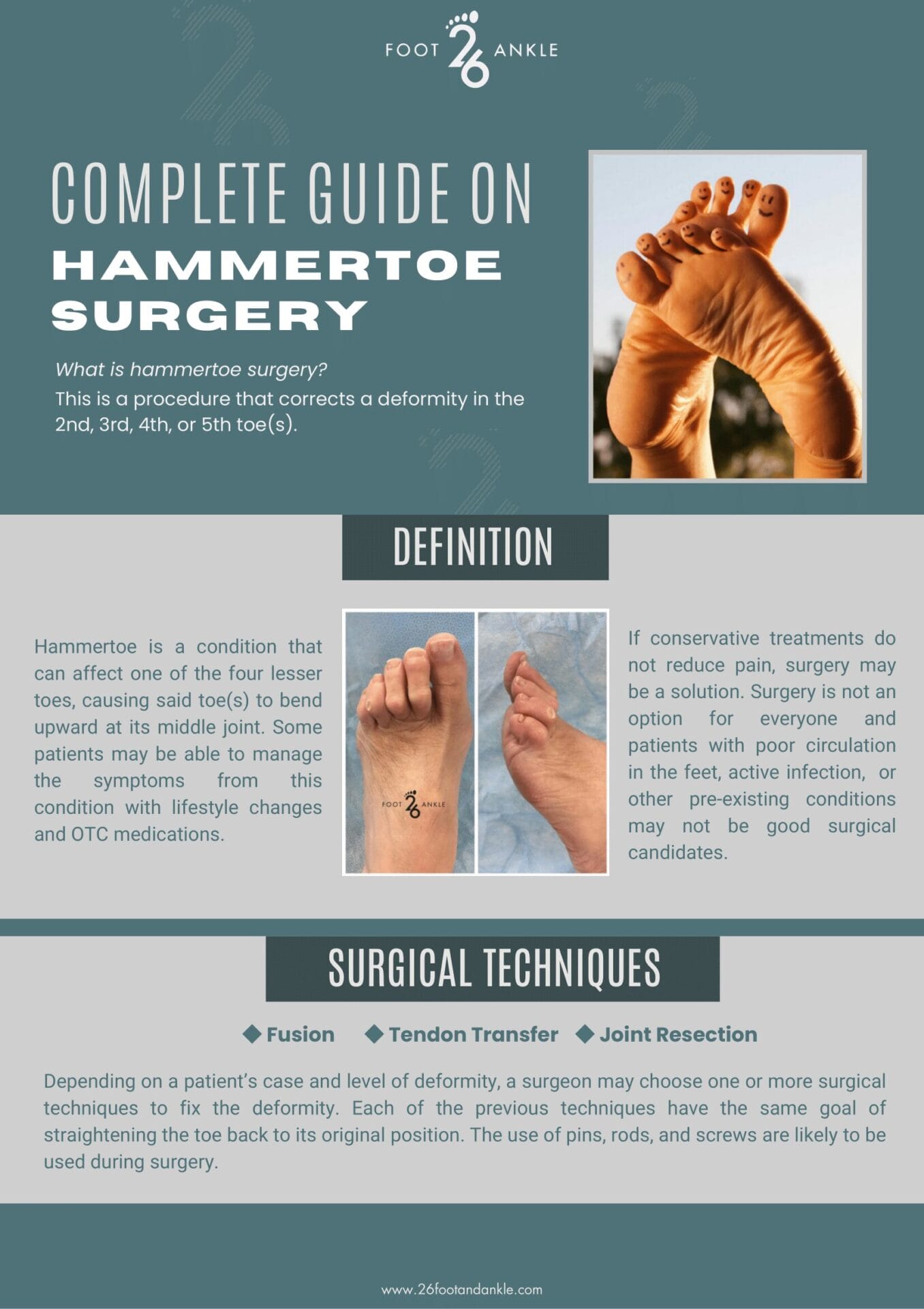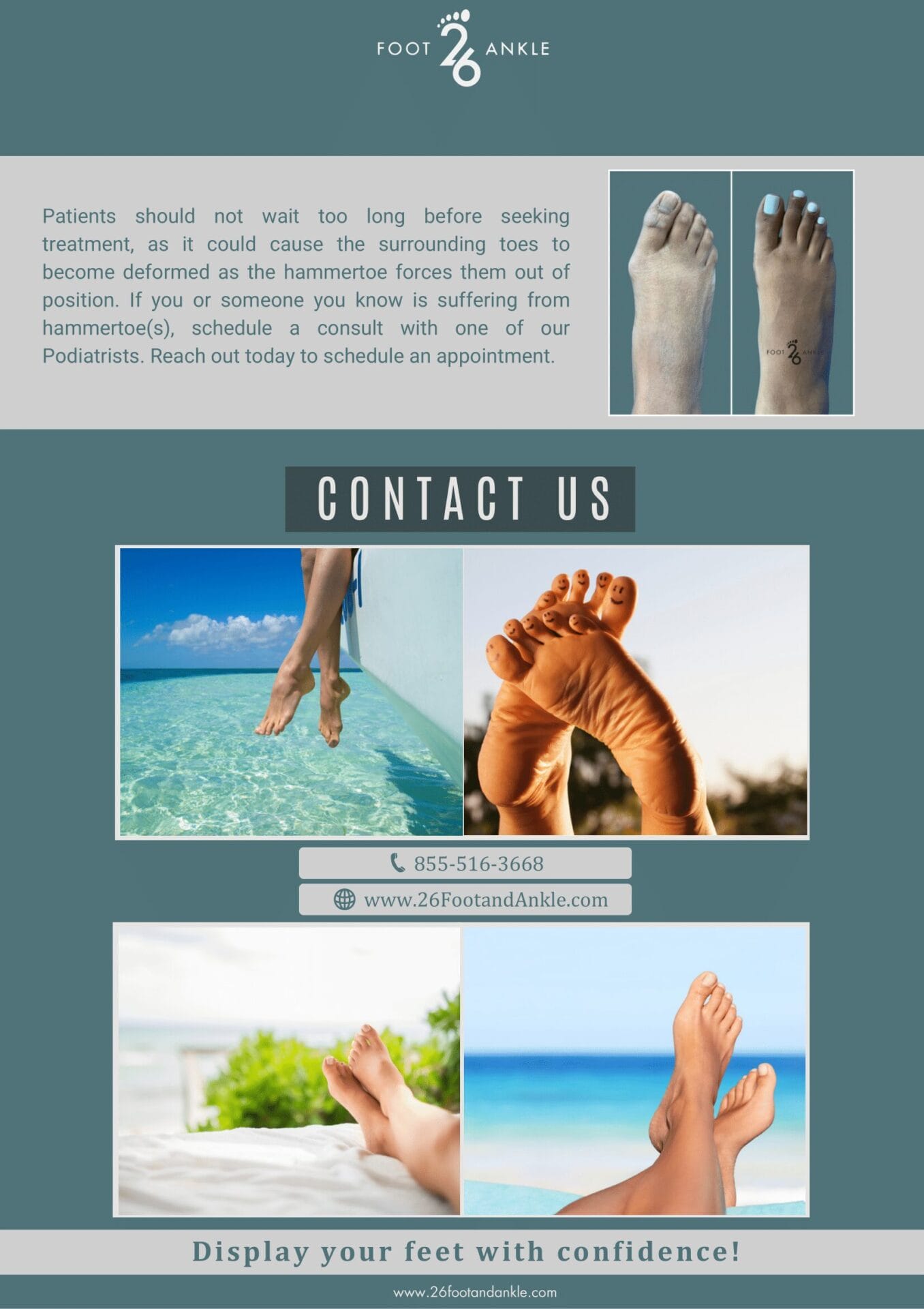The 26 Review
- What is Hammertoe Surgery Procedures that corrects a deformity in the 2nd, 3rd, 4th, or 5th toe(s)
- How The surgeon may opt for a fusion, joint resection, or tendon transfer
- Why To decrease pain and/or improve function of the toes
- Recommended for Patients experiencing pain and digital deformities
- Length of Treatment Surgery lasts roughly 1 hour depending on severity
- Downtime 6 weeks of decreased activities
Hammertoe Surgery E-Book


HAMMERTOE SURGERY
Step into a pain-free future with our ebook on hammertoe surgery! Uncover the solutions to reclaiming your comfort and mobility as you read into expert insights and comprehensive guide included in this ebook. Download now and take the first step towards a life free from hammertoe discomfort!

Let’s take a closer look…
Hammer toe is a condition that affects one of the four lesser toes, causing said toe(s) to bend upward at its middle joint. Some patients may be able to manage the symptoms from this condition with lifestyle changes and OTC medications. However, if conservative treatments do not reduce pain, surgery is a solution for this ailment. Depending on a patient’s case and level of deformity, a surgeon may choose one or more surgical techniques to fix said ailment. Surgery techniques include fusion, tendon transfer, and joint resection. Each of the previous techniques have the same goal of straightening the toe back to its original position. The use of pins, rods, and screws is likely to occur during surgery. Patients that experience poor circulation in the feet, active infection, and other pre-existing conditions may be recommended to not receive this surgery. Speak with your podiatrist to discuss all aspects of this surgery and determine whether it is the correct next step for you.
Procedure Details: Pre, During & Post Surgery Expectations
In preparation for this surgery, pre-operative meetings with a surgeon are highly recommended. During these meetings a surgical plan will be discussed and explained to its full extent. Patients will likely discuss the type of anesthesia that will be used, whether it is general anesthesia or a nerve block. Your podiatrist may suggest a meeting with a physical therapist prior to the surgery. Patients will be taught exercises to do before the procedure to improve balance and strength in the opposite leg, so that moving around after surgery is easier. Lifestyle changes may need to be implemented prior to the procedure as well. Habits like smoking may need to stop, in order to decrease the risk of blood clots and infections during and after surgery. Patients should make arrangements to get home after the surgery, as well as enlist help from family or friends during the recovery period. Since the recovery period takes about 6 weeks, patients should pre-plan staying off their feet as much as possible. On the day of the surgery, the podiatrist will ask their final questions, do a final physical exam, and cleanse the affected area.
During the surgery, twilight anesthesia or a nerve block will be administered to the patient. Once that has been done, an incision will be made on the top of the toe(s). The procedure steps will vary depending on whether the patient’s hammertoe is flexible or fixed. For flexible hammertoes, surgery may involve the transferring of tendons. By transferring the tendons from the bottom of the toe to the top, it aids in straightening the joint. One of the two tendons located on the bottom toe would be transferred and reattached to the top of the joint. For fixed hammertoes, the procedure may include fusion and/or joint resectioning. In joint resection, an incision will be made on the top of the toe. Ligaments and tendons may be cut to help straighten the top. The end of the bone can also be removed to allow the toe to fully extend. Small metal pins or rods are typically used to keep the toe straight during the healing process. With fusion, a surgeon will cut the ligaments and tendons, as well as the ends of the bone at the joint. K-wire, pins, or rods are usually used while the ends of the bone fuse together and heal.
Hammertoe surgery is an outpatient surgery, meaning once a patient has waited the alloted time in the recovery room, they can return home the same day. Patients will be given a surgical shoe or boot to wear home and surgeons recommend OTC pain medication following the procedure. Recovery typically takes around 6 weeks for most patients depending on what the surgery entailed. Depending on which foot is worked on, patients may not be able to drive for a few weeks following the surgery. About every 2 to 4 weeks, patients will need to return to their surgeon’s office to have their bandages replaced. Stitches are usually removed 2 to 3 weeks after the surgery, while any pins or rods may be taken out after 3 to 4 weeks. While resting, make sure to elevate the foot and avoid putting weight on the affected area as best as possible. Working with a physical therapist is highly recommended to regain flexibility in the affected toe(s).

Benefits and Risk Factors
Like most surgeries, there are serious benefits and risk factors to consider before getting the surgery done. Speaking with your podiatrist about any questions or concerns is highly recommended. The main benefits that come with hammertoe surgery include regained mobility in the toe(s), pain relief, and improved balance and/or flexibility. With every surgery there comes the potential risk for problems. Luckily, most of the potential issues that could arise are preventable and fixable. During surgery there are a few risks that could occur, including: infection, nerve damage, blood clot formation, or a bad reaction to the anesthesia. Complications specific to hammertoe surgery can also include the possibility of the toe curling up again, however this is rare. It is also possible that the bones don’t heal properly after the fusion procedure. If a patient’s hammertoe returns, which is unlikely, a second surgery may be necessary. Hammertoe surgery should relieve pain, discomfort, and cosmetic concerns, without any complications. Patients should not wait too long before seeking treatment, as it could cause the surrounding toes to become deformed as the hammertoe forces them out of position. If you or someone you know is suffering from hammertoe, speaking with a podiatrist as soon as possible is recommended for treatment to occur.